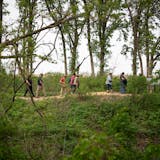Glenn Del Giudice, a longtime Department of Natural Resources wildlife researcher known for his yearslong studies of whitetail deer habitat and threats to Minnesota's fragile moose population, has died. He was 68.
"He made a name for himself well beyond the boundaries of Minnesota,'' said Mike Larson, supervisor of the DNR's forest wildlife research group where Del Giudice was a high-ranking senior scientist. "He had a towering reputation … active in teaching and collaborating with scientists across the world.''
Larson said Del Giudice had planned to retire next week. The researcher's death was unexpected but followed a weekslong hospital stay, Larson said.
Larson said it is daunting to try to characterize the scope of Del Giudice's work, but he conducted foundational work in deer and moose ecologies, especially surrounding their winter habitat needs. He strived to incorporate the best and latest technologies in his research, often breaking ground on methodologies.
Many students and professional wildlife biologists alike were trained by Del Giudice in the safe capture and handling of deer and moose for research projects. He also was the DNR's go-to expert on interactions among deer, moose and wolves, Larson said.
In 1996, the Star Tribune noted at the time that Del Giudice was "among a handful of deer researchers employed by the Department of Natural Resources who help keep Minnesota at the forefront of whitetail management worldwide."
He was several years into a 12-year study of whitetails and their dependence on stands of conifers mixed with older aspen to endure harsh winters. Those wintering areas were in decline Up North and Del Giudice was still collecting data on the importance of winter habitat for deer at a research location near Remer.
Tom Rusch, a retired DNR wildlife manager from Tower who worked with Del Giudice for 35 years, said he was a pillar in the whitetail and moose research communities across North America. His loss will be felt immediately next week when DNR crews once again launch the department's aerial moose survey, a vital annual tool that has helped the state track the population decline of the species.
![Three weeks ago, Octavio Rodriguez switched from making transmission parts to casting parts for hospital bed brake assemblies at Twin City Die Castings. ] GLEN STUBBE • glen.stubbe@startribune.com Thursday, April 9, 2020 How employee-owned Twin City Die Casting, which just laid off 40 production workers of its 250 employees in what was supposed to be a good year, is trying to accelerate its pivot to growing medical parts business for ventilators, hospital beds, etc as it copes with instan](https://arc.stimg.co/startribunemedia/WNZYKGTZ5IYMUCO3KI5TR3N7WI.jpg?&w=80&ar=1:1&fit=crop)
djoles@startribune.com As boaters flock to Minnesota lakes and rivers this holiday weekend for the unofficial kick-off to the boating season, they'll face more inspections in and out of the water as local cities and counties ramp up their work to stop the spread of invasive species. Across the metro, more boat accesses will be staffed by watercraft inspectors thanks to $10 million funneled to county government programs this year, up from $4.5 million the state allocated last year. ORG XMIT: MIN1505222156290209 ORG XMIT: MIN1506021218440580](https://arc.stimg.co/startribunemedia/34QSKO44B2XKVNUZCO5SLJQSLY.jpg?&w=80&ar=1:1&fit=crop)

